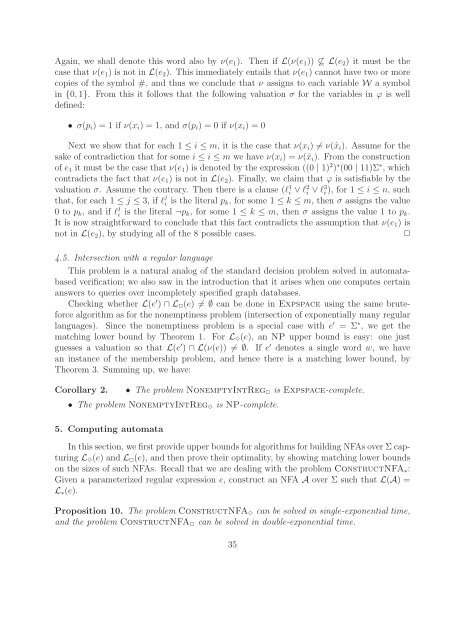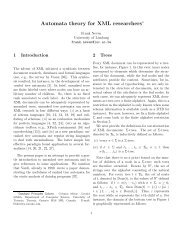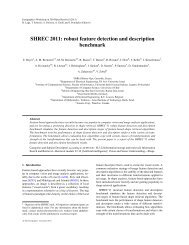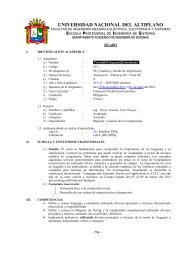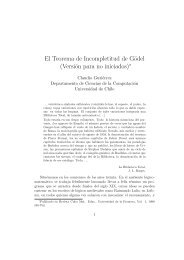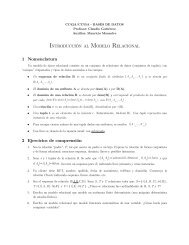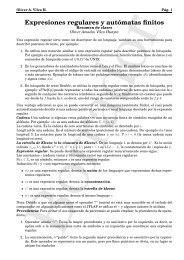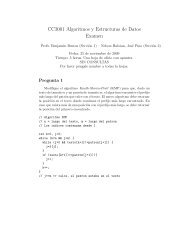problem. In fact, if A ν(e1 )∩A C e 2 ≠ ∅, then there is a word w ∈ L(ν(e 1 )), <strong>and</strong> hence in L ✸ (e 1 ),that does not belong to L ✸ (e 2 ). This implies that L ✸ (e 1 ) is not contained in L ✸ (e 2 ). Onthe other h<strong>and</strong>, it is clear that if A ν(e1 )∩A C e 2= ∅ for all possible valuations ν from W to Σ,then L ✸ (e 1 ) is contained in L ✸ (e 2 ).Thelowerboundisestablishedviaareductionfrom3-SATtothecomplementofContainment ✷ (·,ewhere e 2 is the following regular expression over the alphabet Σ = {0,1,#}:e 2 := ( (10 | 01) ∗ #((0 | 1) 3 ) ∗ 000((0 | 1) 3 ) ∗) | ( ((0 | 1) 2 ) ∗ (00 | 11)Σ ∗) | ( Σ ∗ #Σ ∗ #Σ ∗) .Notice that e 2 mentions no variables, <strong>and</strong> hence L ✸ (e 2 ) = L(e 2 ).Letϕ = ∧ 1≤i≤n (l1 i∨l 2 i∨l 3 i)beapropositionalformulain3-CNFovervariables{p 1 ,...,p m }.That is, each literal l j i , for 1 ≤ i ≤ n <strong>and</strong> 1 ≤ j ≤ 3, is either p k or ¬p k , for 1 ≤ k ≤ m. Nextwe show how to construct in polynomial time from ϕ a parameterized regular expression e 1over the alphabet Σ = {0,1,#} such that ϕ is satisfiable if <strong>and</strong> only if L ✸ (e 1 ) ⊈ L(e 2 ).Let W = {x i ,ˆx i | 1 ≤ i ≤ m}. Intuitively, each x i represents the value assigned to p i ,<strong>and</strong> ˆx i represents the value of ¬p i . Moreover, assume that h is a mapping from the literalsl j i (1 ≤ i ≤ n <strong>and</strong> 1 ≤ j ≤ 3) to W, defined as expected: h(l j i ) = x k if l j i is p k , for some1 ≤ k ≤ m, <strong>and</strong> h(l j i ) = ˆx k if l j i is ¬p k.Define e 1 as follows:e 1 = x 1ˆx 1···x mˆx m #h(l 1 1 )h(l2 1 )h(l3 1 )···h(l1 n )h(l2 n )h(l3 n ).We show that ϕ is satisfiable if <strong>and</strong> only if L ✸ (e 1 ) ⊈ L(e 2 ).(⇒): Assume that ϕ is satisfiable by valuation σ. Let ν be a valuation from W to Σ,defined as follows:• For each 1 ≤ k ≤ m, ν(x k ) = 1 if σ(p k ) = 1, <strong>and</strong> ν(x k ) = 0 otherwise.• For each 1 ≤ k ≤ m, ν(ˆx k ) = 0 if σ(p k ) = 1, <strong>and</strong> ν(ˆx k ) = 1 otherwise.Notice that L(ν(e 1 )) consists of the single word:ν(x 1 )ν(ˆx 1 )···ν(x m )ν(ˆx m )#ν(h(l 1 1))ν(h(l 2 1))ν(h(l 3 1))···ν(h(l 1 n))ν(h(l 2 n))ν(h(l 3 n)).We shall abuse notation <strong>and</strong> denote by ν(e 1 ) both this word <strong>and</strong> the aforementioned expression.It is clear that ν(e 1 ) contains a single symbol #, <strong>and</strong> starts with a prefix in(01 | 10) ∗ #. Thus, if L ✸ (e 1 ) ⊆ L(e 2 ) it must be that ν(e 1 ) is defined by the expression(10 | 01) ∗ #((0 | 1) 3 ) ∗ 000((0 | 1) 3 ) ∗ . But this implies that there are literals l 1 i, l 2 i <strong>and</strong> l 3 i, forsome 1 ≤ i ≤ n, such that ν(h(l 1 i ))ν(h(l2 i ))ν(h(l3 i )) = 000. By construction of ν, it must bethe case that σ falsifies the i-th clause of ϕ, which contradicts the fact that σ is a satisfyingassignment.(⇐): Assume on the other h<strong>and</strong> that L ✸ (e 1 ) ⊈ L(e 2 ). From the definition of the ✸-semantics, there is at least one valuation ν from W to Σ such that L(ν(e 1 )) ⊈ L(e 2 ). Noticeagain that, by construction of e 1 , ν(e 1 ) consists of the single word:ν(x 1 )ν(ˆx 1 )···ν(x m )ν(ˆx m )#ν(h(l 1 1 ))ν(h(l2 1 ))ν(h(l3 1 ))···ν(h(l1 n ))ν(h(l2 n ))ν(h(l3 n )).34
Again, we shall denote this word also by ν(e 1 ). Then if L(ν(e 1 )) ⊈ L(e 2 ) it must be thecase that ν(e 1 ) is not in L(e 2 ). This immediately entails that ν(e 1 ) cannot have two or morecopies of the symbol #, <strong>and</strong> thus we conclude that ν assigns to each variable W a symbolin {0,1}. From this it follows that the following valuation σ for the variables in ϕ is welldefined:• σ(p i ) = 1 if ν(x i ) = 1, <strong>and</strong> σ(p i ) = 0 if ν(x i ) = 0Next we show that for each 1 ≤ i ≤ m, it is the case that ν(x i ) ≠ ν(ˆx i ). Assume for thesake of contradiction that for some i ≤ i ≤ m we have ν(x i ) = ν(ˆx i ). From the constructionof e 1 it must be the case that ν(e 1 ) is denoted by the expression ((0 | 1) 2 ) ∗ (00 | 11)Σ ∗ , whichcontradicts the fact that ν(e 1 ) is not in L(e 2 ). Finally, we claim that ϕ is satisfiable by thevaluation σ. Assume the contrary. Then there is a clause (l 1 i ∨l 2 i ∨l 3 i), for 1 ≤ i ≤ n, suchthat, for each 1 ≤ j ≤ 3, if l j i is the literal p k, for some 1 ≤ k ≤ m, then σ assigns the value0 to p k , <strong>and</strong> if l j i is the literal ¬p k , for some 1 ≤ k ≤ m, then σ assigns the value 1 to p k .It is now straightforward to conclude that this fact contradicts the assumption that ν(e 1 ) isnot in L(e 2 ), by studying all of the 8 possible cases.✷4.5. Intersection with a regular languageThis problem is a natural analog of the st<strong>and</strong>ard decision problem solved in automatabasedverification; we also saw in the introduction that it arises when one computes certainanswers to queries over incompletely specified graph databases.Checking whether L(e ′ ) ∩ L ✷ (e) ≠ ∅ can be done in Expspace using the same bruteforcealgorithm as for the nonemptiness problem (intersection of exponentially many regularlanguages). Since the nonemptiness problem is a special case with e ′ = Σ ∗ , we get thematching lower bound by Theorem 1. For L ✸ (e), an NP upper bound is easy: one justguesses a valuation so that L(e ′ ) ∩ L(ν(e)) ≠ ∅. If e ′ denotes a single word w, we havean instance of the membership problem, <strong>and</strong> hence there is a matching lower bound, byTheorem 3. Summing up, we have:Corollary 2.• The problem NonemptyIntReg ✷ is Expspace-complete.• The problem NonemptyIntReg ✸ is NP-complete.5. Computing automataInthissection, wefirstprovideupperboundsforalgorithmsforbuildingNFAsoverΣcapturingL ✸ (e) <strong>and</strong> L ✷ (e), <strong>and</strong> then prove their optimality, by showing matching lower boundson the sizes of such NFAs. Recall that we are dealing with the problem ConstructNFA ∗ :Given a parameterized regular expression e, construct an NFA A over Σ such that L(A) =L ∗ (e).Proposition 10. The problem ConstructNFA ✸ can be solved in single-exponential time,<strong>and</strong> the problem ConstructNFA ✷ can be solved in double-exponential time.35
- Page 1 and 2: Parameterized Regular Expressions a
- Page 3 and 4: sequence prediction for dynamic mem
- Page 5 and 6: set of variables in V, can of cours
- Page 7 and 8: Lemma 2. Given a set e 1 ,...,e k o
- Page 9 and 10: code an accepting run τ for M on i
- Page 11 and 12: polynomial number of regular expres
- Page 13 and 14: polynomial with respect to E (Mn,1
- Page 15 and 16: • The case where for some 1 ≤ k
- Page 17 and 18: a different variable x i ∈ V. We
- Page 19 and 20: time with respect to the size of A
- Page 21 and 22: Next we show that ϕ is satisfiable
- Page 23 and 24: 3. For each word w ∈ Σ ∗ , the
- Page 25 and 26: Next we show that there is an imple
- Page 27 and 28: Finally, it suffices to perform a r
- Page 29 and 30: that the sequence of configurations
- Page 31 and 32: e 5 6 =⋃(a,q) | δ(q,a)=(q ′ ,a
- Page 33: 4.4. ContainmentRecall that the Con
- Page 37 and 38: Given a collection S of words over
- Page 39 and 40: • its size is at most exponential
- Page 41 and 42: states from A e . One reads words o
- Page 43: [20] W. Gelade, F. Neven, Succinctn


